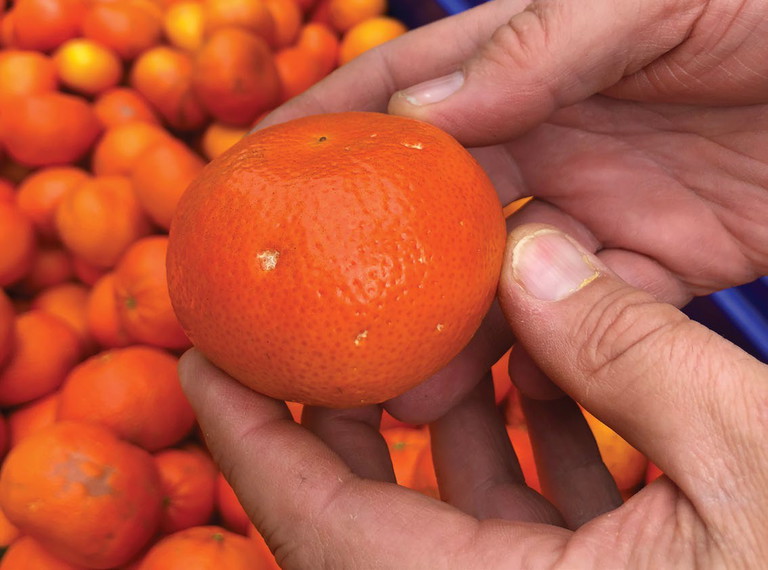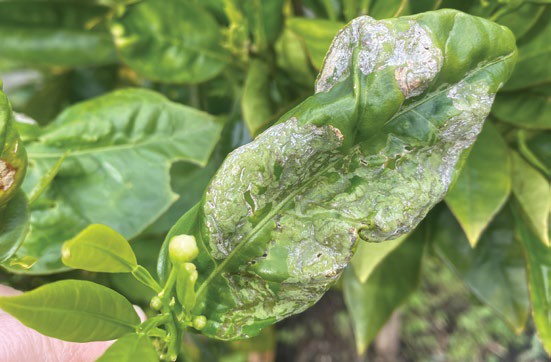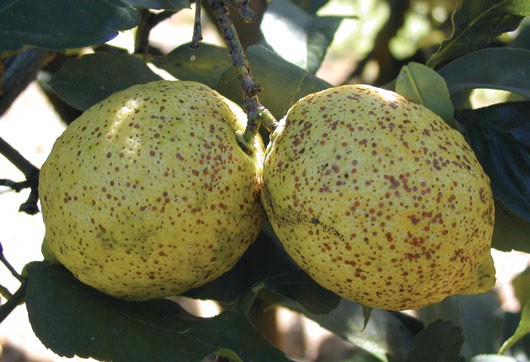
Citric
warfare
Defend your orchard against the attack of autumnal pests and diseases with a targeted IPDM offensive.
SNAIL damage on fruit.

BY RACHELLE JOHNSTONE
RESEARCH SCIENTIST,
DPIRD
As temperatures cool and rains begin in autumn, snails become more active in citrus orchards and there is an increased risk of fungal diseases spreading. As fruit develops, red scale can become an issue, while citrus leafminer can cause damage to new flush on young trees.
Pest and disease monitoring is extremely important to keep ahead of potential problems, especially if you are implementing integrated pest and disease management (IPDM) in your orchard.
In this article, we talk about some key citrus pests, monitoring protocols and disease management strategies to focus on at this time of the year.
Autumn copper spray
An important focus for autumn is to apply protective copper sprays before the first rains. WA growers have found that diseases are not a problem every year, but can cause serious damage when they do occur. Preventative copper-based fungicides can be used for management of several fungal diseases of citrus, such as phytophthora, core rot, alternaria brown spot and anthracnose.
Copper will only protect the areas where it lands on foliage and fruit, so even distribution and good retention are crucial for successful disease management. Sprayers should be calibrated and checked regularly to ensure good coverage.
Fungal spores can linger on dead wood in the canopy. Pruning and removing dead wood from the orchard, along with fallen fruit and leaf litter, will reduce infection levels from diseases such as anthracnose (Colletotrichum gloeosporioides).
“ Brown garden snails are the most common species causing damage, while small conical snails are also an issue. ”
For more information on copper sprays, see NSW DPI Primefact 757 ‘Using copper sprays to control diseases in citrus’. www.dpi.nsw.gov.au/agriculture/ horticulture/citrus/content/cropmanagement/orchard-managementfactsheets/copper-sprays.
Autumn pest monitoring
Snails
These cause damage in citrus orchards by feeding on ripe and ripening fruit, leaves of young trees and young tree bark. Fruit damage appears as circular chewed areas in the rind. Brown garden snails are the most common species causing damage, while small conical snails are also an issue. Monitor in the early morning or evening when conditions are cooler, or after irrigating, when snails will be more active.
Baiting should begin when snails start to move and feed in early autumn and before they start laying eggs, which is usually after the first heavy rains of the season.
Seasonal field walk
The Citrus Integrated Pest and Disease Management (IPDM) extension project team in WA will be holding a seasonal field walk at the end of March with a focus on disease management and spray application. Keep an eye on your inbox for details in the WA Citrus E-News. Please contact DPIRD research scientist Rachelle Johnstone (rachelle.johnstone@dpird.wa.gov.au) for more information or to register your interest.

1: Citrus leafminer damage.

2: Damage from citrus gall wasp on stems.

3: Red scale damage on lemons.
Apply baits immediately after rain or irrigation when the soil is wet and snails are active. Bait performance will be improved by applying evenly across the orchard and clearing the ground by mowing or spraying weeds before application. More information at www. agric.wa.gov.au/citrus/managingsnails-citrus-orchards.
Red scale
This infests leaves, fruits and branches of all citrus varieties (see image above). Heavy infestations cause leaf drop and twig dieback. Scale-damaged fruit is downgraded and it is a quarantine pest of concern for some export markets.
Monitor red scale at least monthly until harvest, checking five random fruits on at least 10 random trees per block. Take appropriate actions if 10% or more of fruits of early varieties are infested or 15–20% or more of later varieties.
Citrus gall wasp
While citrus gall wasp is yet to be reported in commercial citrus orchards in WA, trees should be monitored from April. Look for small bulges on spring flush, particularly in the lower canopy (see image). See the DPIRD citrus gall wasp control webpage for more information at www.agric.wa.gov.au/ citrus-gall-wasp.
Fuller’s rose weevil
Adults of this pest will emerge from the soil between February and May and climb into trees. They cause damage by feeding on leaves and laying eggs under the calyx, causing problems for some export markets.
Monitor 10 to 20 trees per block fortnightly. Examine low-hanging fruit near the trunk, looking for egg masses under the calyx and check foliage for feeding damage. Place a one-metresquare mat of light-coloured shade cloth under the tree, vigorously shake a branch six times and check for fallen adult weevils.
“ While citrus gall wasp is yet to be reported in commercial citrus orchards in WA, trees should be monitored from April. ”
Leafminer
Citrus leafminer larvae damage young-growth flush by causing leaves to twist and curl. Damage is easily identified by the mines that the larvae produce in the leaves (see image). Older trees can usually sustain damage, but young trees can be severely affected.
Monitor significant growth flushes (more than 25% of trees flushing) on trees less than five years old. Examine at least 20 advanced shoots (those that have emerged earlier) and take action if 10% or more advanced flushes are infested. Horticultural spray oils can reduce egg laying, but the larvae is difficult to control as it is protected by the leaf. Infestations can be reduced by pruning autumn growth flushes.
MORE INFORMATION
Contact Rachelle Johnstone at rachelle.johnstone@dpird.wa.gov.au
Department of Primary Industries and Regional Development
CITRUS FUND
The project has been funded by Hort Innovation, using the citrus research and development levy and contributions from the WA Department of Primary Industries and Regional Development, WA citrus growers and the Australian Government. Hort Innovation is the grower owned, not-for-profit research and development corporation for Australian horticulture.